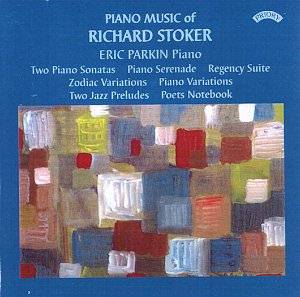
"A recurrent theme in my work is the surprises in everyday
life which are original and unique, often 'noticed' and 'heard' whilst travelling
on train or underground, or crossing stations or browsing in book shops"
Thus Richard Stoker introducing his contribution to 'A Passage of Time'
(Spotlight Poets 1999) For a creative artist whose thoughts are expressed
in music, verse, drama, novels and short stories as well as on canvas the
above 'credo' suggests a dissipation of energies! The most striking impression
one receives from this CD of Stoker's piano compositions is that the amount
of energy channelled here into the music must surely leave little enough
for other diverse fields - and yet the colourful sleeve design, -his own
Abstract No 1 - is equally expressive of a fierce energy!
Richard Stoker was born in Yorkshire in 1938. His studies with Harold Truscott
and Lennox Berkeley were followed, on a Mendelssohn scholarship, by a period
in Paris with Nadia Boulanger. His piano music, including as it does three
sets of charmingly poetic music in a quasi-Gallic vein, two sets of Variations,
two extensive Piano Sonatas and a richly luscious set of two Jazz Preludes
(on lyrics of his own, the second of which has a haunting folk-like melody
that lingers long in the memory), is convincingly played on this well recorded
disc by Eric Parkin. In his idiosyncratic sleeve note the composer uses the
adjective 'pointillistic' - and this is certainly apt in connection with
the five-movement Serenade, the Regency Suite and 'A Poet's
Notebook' (whose 'Parody' movement cleverly conceals 'a notable East
Anglian composer' whom he doesn't identify!) Each movement of these is concerned
with colour, pianistic colour illuminating deliciously poised, almost balletic,
melodic lines and a sure contrapuntal sense (derived I would guess from his
teacher Lennox Berkeley - the energy mentioned undoubtedly from Harold Truscott)
Stoker's seemingly capricious shifts in tonality have purpose, as he himself
writes
'
Manual dexterity has extreme mobility
Shaping patterns painter-like in the air
With feats of skill so remarkably precise'
(The Juggler from 'A Passage of Time)
The Piano Variations of opus 45 explore the range of equally pointillistic
effects, the prismatic colours firmly anchored by repeated pedal notes. In
contrast the eleven succinct variations on the opening 'Crab' theme
of the 'Zodiac Variations' are lightweight, linear in construction
- and since of moderate difficulty, provide a useful introduction to his
style.
The two Sonatas are heavier material. The first's sombre opening is soon
pierced by shafts of light -the music ranging from dark chords to sharply
repeated extended octaves. A chorale-like bass in 5/4 provides the material
for the second of the txxo movements.
The second of the Sonatas is a big work in five movements (the titles of
which indicate the mood Sonare, Cantare, Toccare etc) The Sonata was written
for the pianist Eric Parkin and is a virtuosic work. After a chordal introduction
a restless rhythmic figure appears dominating the central section, ending
in "two cadence-like chords". The first of the two Adagio movements - a dark-hued
exercise in contrapuntal movement - and a second Adagio frame a central
'Scherzare' whose whole-tone colouring provides atmospheric contrast. The
two cadential chords lead into the second Adagio and here the composer gives
the pianist a free hand with the melodic rhythms -"the parameters, as in
jazz, undefined". The concluding 'Toccare' rounds up the musical argument,
incorporating material from the earlier movements and also hearking back
to the first Sonata of some 25 years earlier.
Reviewer
Colin Scott-Sutherland

